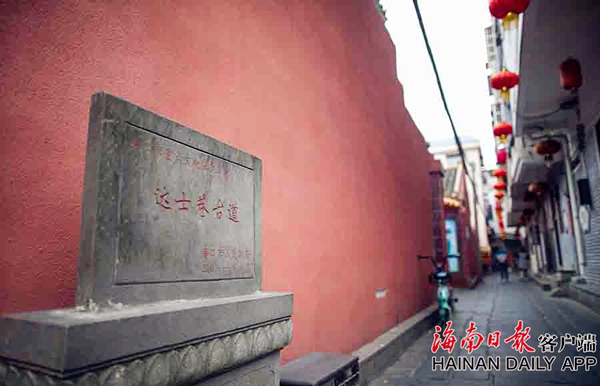Hainan's impressive Dashi Alley recognized


People walk down the ancient Dashi Alley in Haikou city. [Photo by Song Guoqiang/Hainan Daily APP]
The Department of Tourism, Culture, Radio, Television, Publication and Sports of Hainan Province recently announced the fourth set of provincial-level cultural relic protection sites. Thirty-eight ancient architectural structures were on the recommendation list.
Dashi Alley, known as the most famous alley of the Ming (1368-1644) and Qing (1644-1911) dynasties, was selected as a key historical site in Haikou city. Located west of Ma'an Street, Fucheng town in Qiongshan district, the alley used to be a residential area for celebrities and rich families. It extends for about 400 meters from east to west and is about 2.5 meters in width. The ground has no gaps and consists of regular rectangular lava stones 45 cm long, 40 cm wide and six cm thick.

Traditional architecture in Dashi Alley consists of distinct local features. [Photo by Song Guoqiang/Hainan Daily APP]
The ancient Dashi Alley has a long history and consistently impresses visitors with its old architectural style and distinctive features. After its formation during the Ming Dynasty, many squires and scholars came to build their houses and begin developing literature and education there, leading to the area's transformation.
The former residences of a number of historical figures are situated in the alley, including the former houses of local notables like Wang Guoxian, a noted scholar and educator from the late Qing Dynasty and the early Republic of China, and Zhong Fang, a renowned Confucian scholar and politician from the Ming Dynasty. The 9.6-meter-deep Zhongfang Well made from a whole block of stone is a key relic site and was elaborately built to commemorate Zhong Fang.
Three neighboring ancient temples, Sansheng, Mahuang and Kanggong, are located in the eastern part of the alley.

Dashi Alley is selected as a key relic protection site in Haikou, Hainan province. [Photo by Song Guoqiang/Hainan Daily APP]
MOST POPULAR
Editors' Picks
 Infographic:
Milestones in China's high-speed railway development
Infographic:
Milestones in China's high-speed railway development
 Infographic:
China's NEV industry performance review
Infographic:
China's NEV industry performance review
 Infographic:
China's low-altitude economy: A transformative force
Infographic:
China's low-altitude economy: A transformative force




